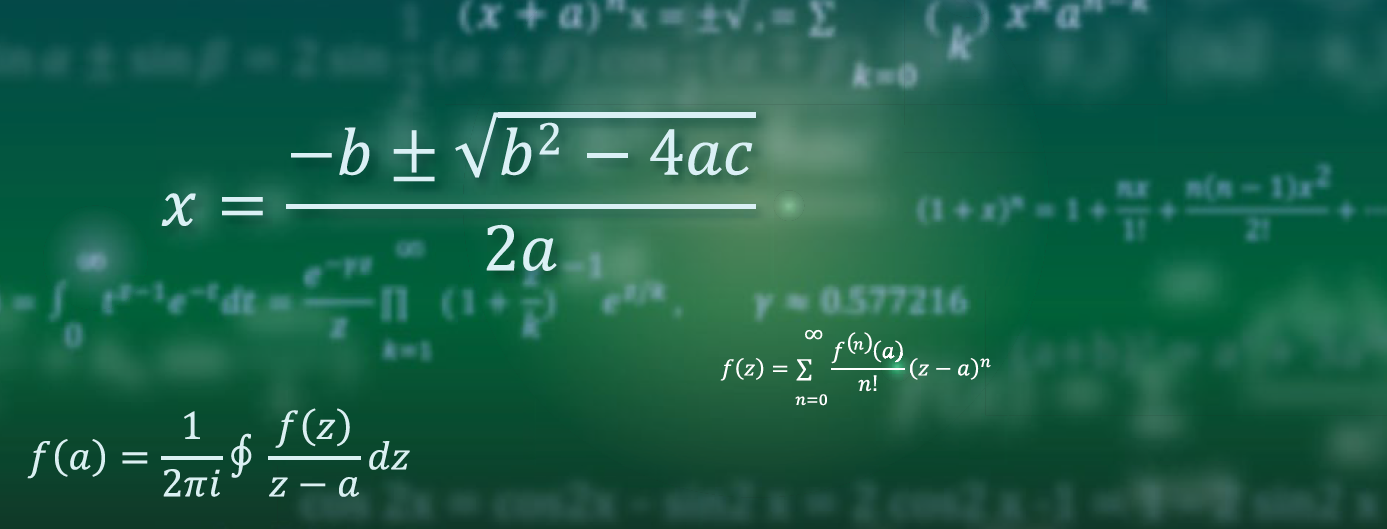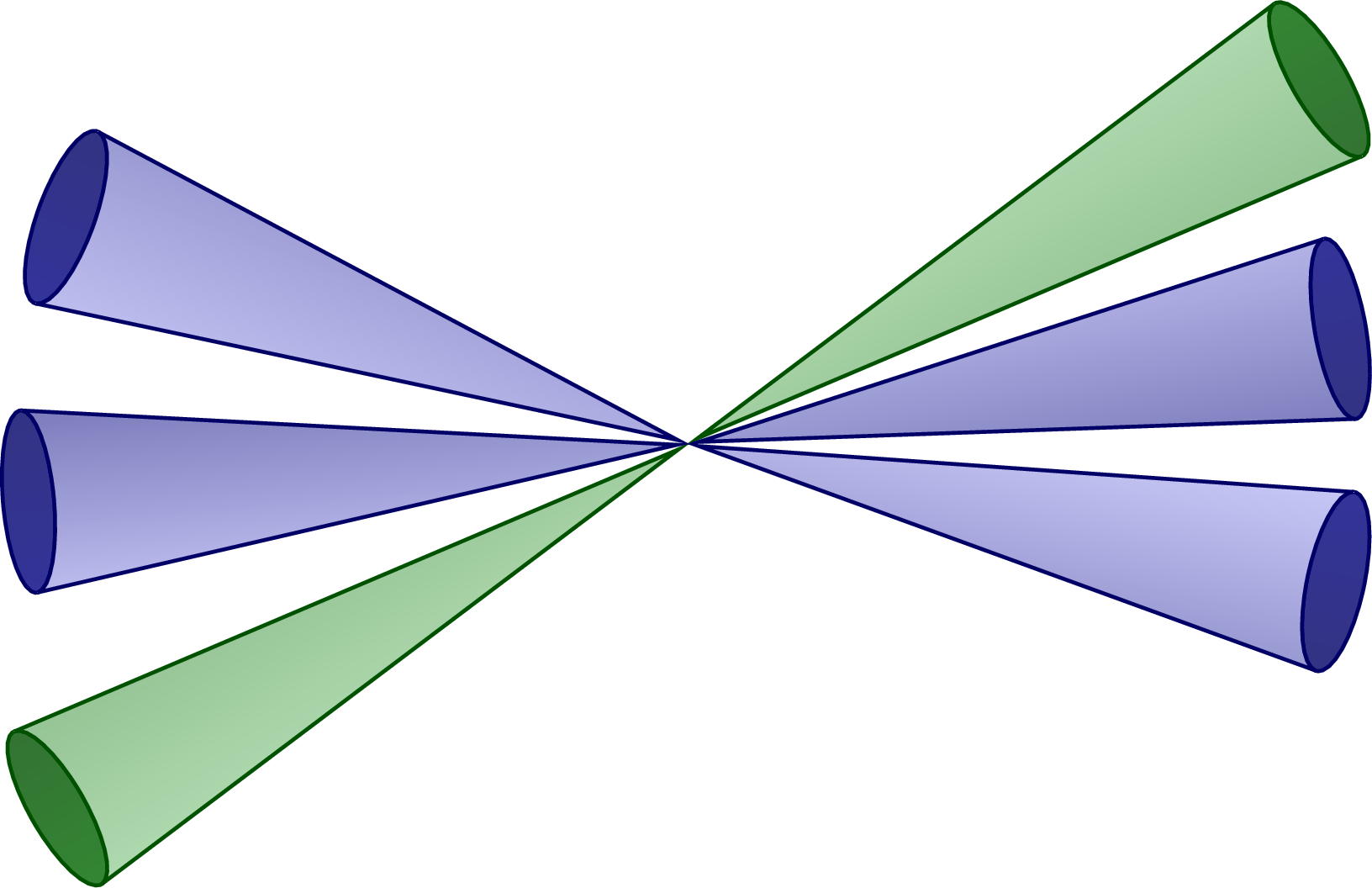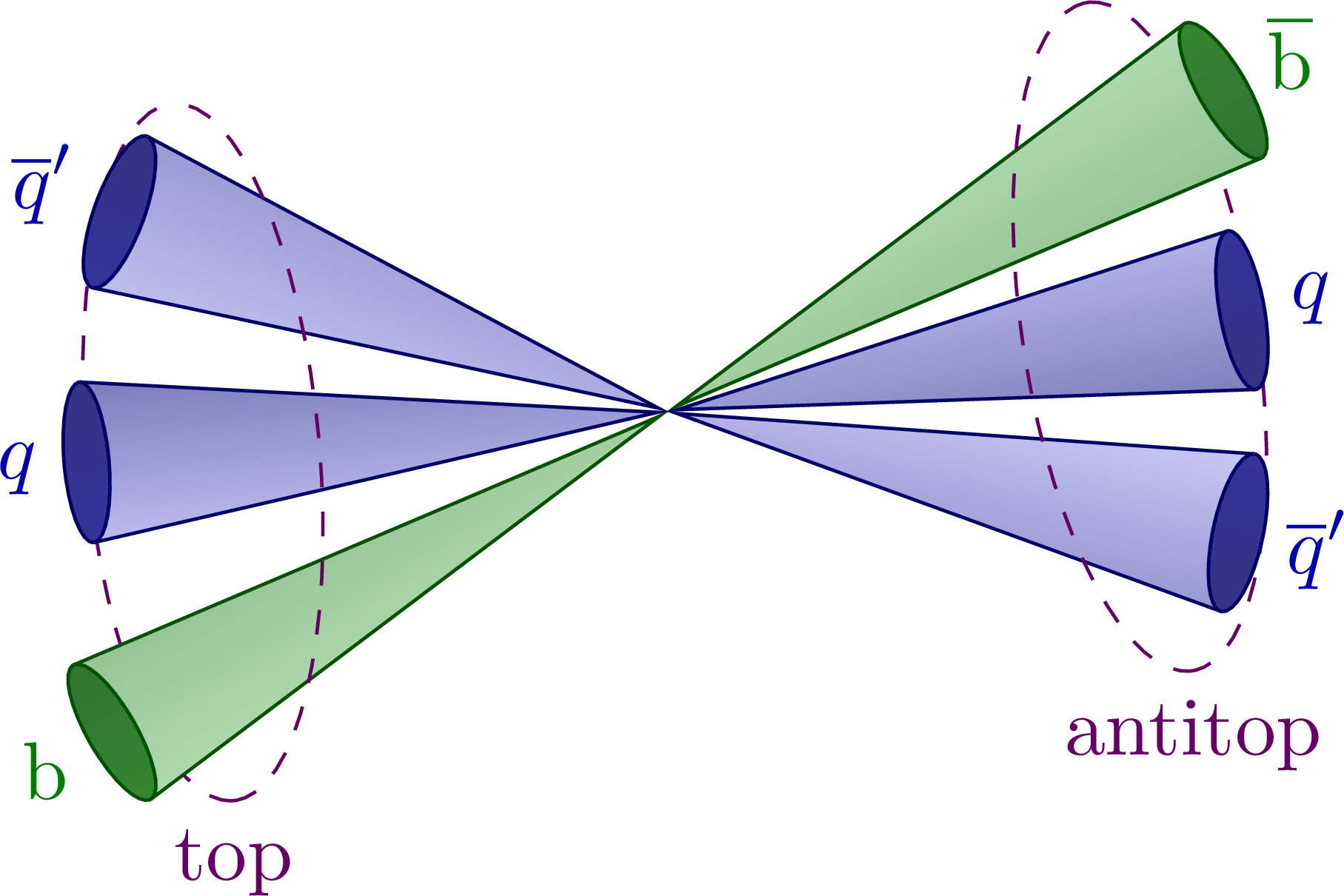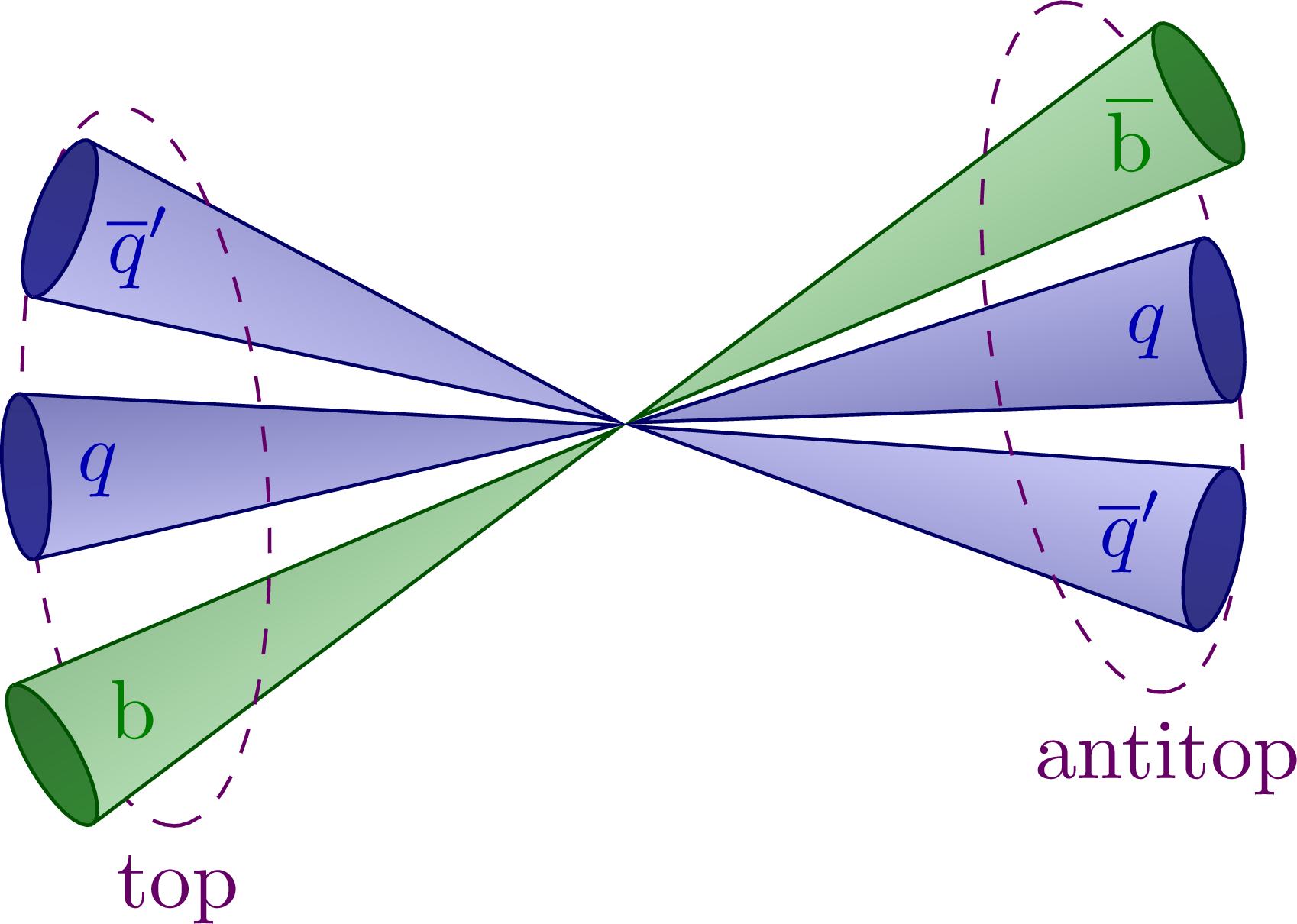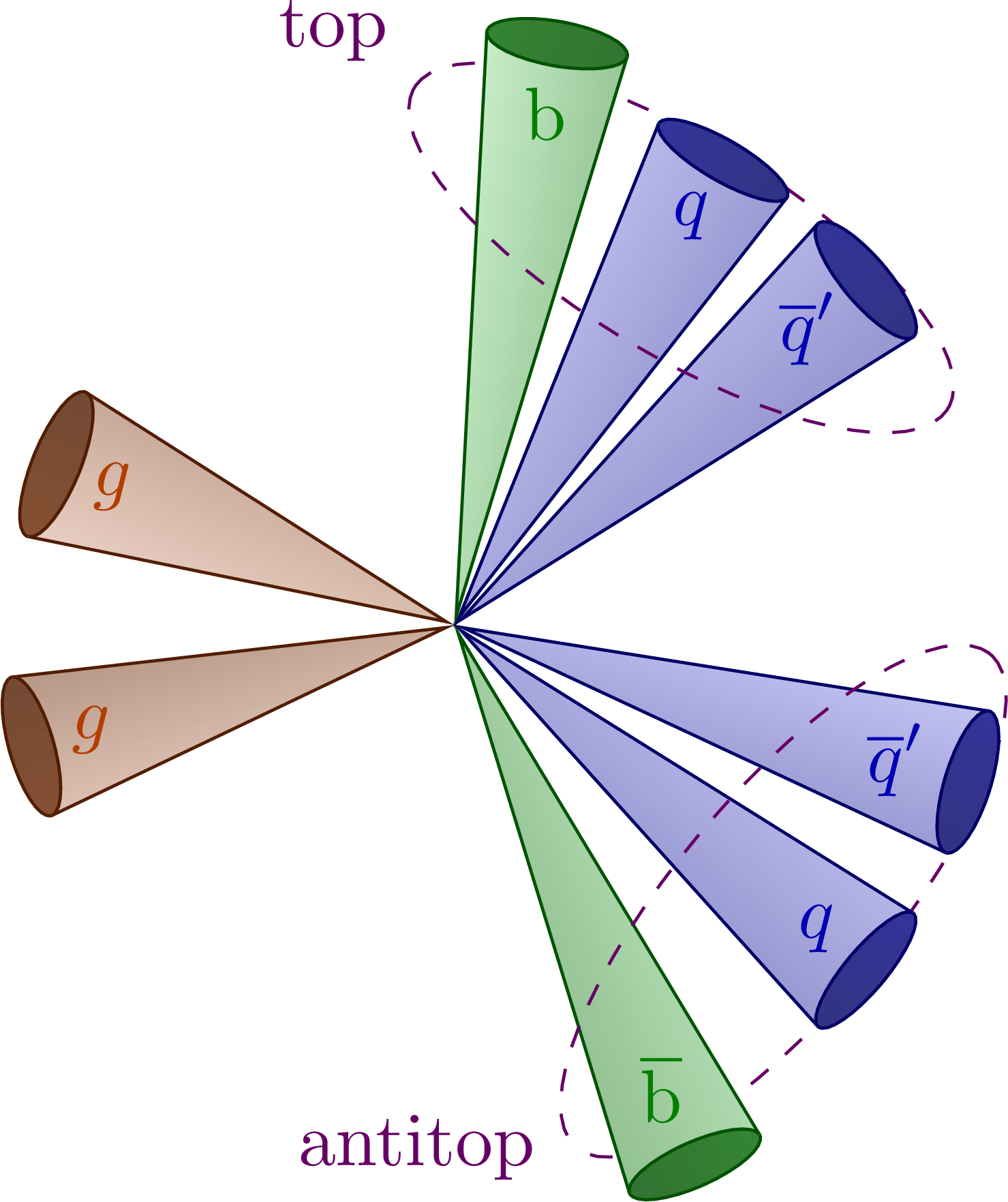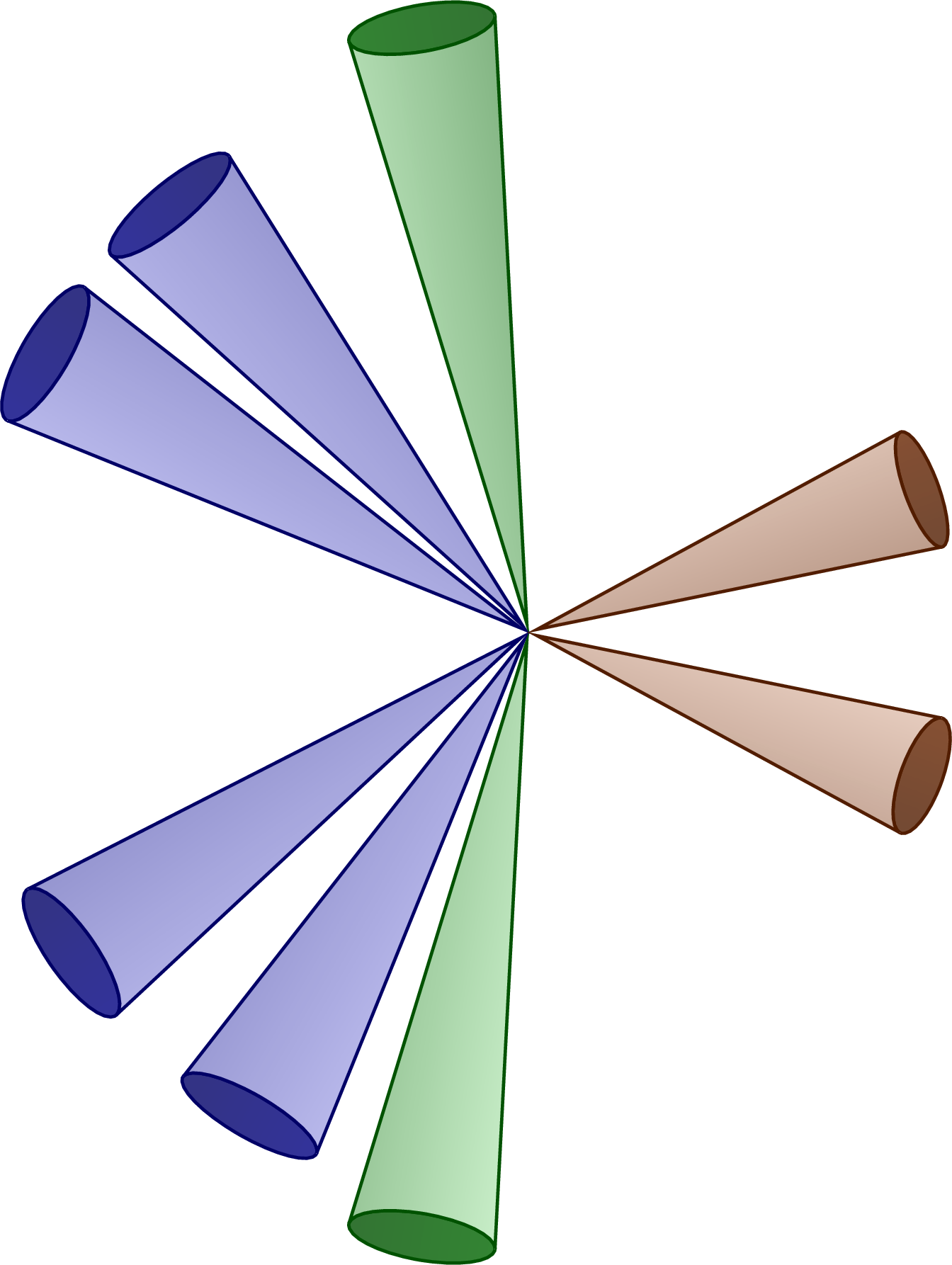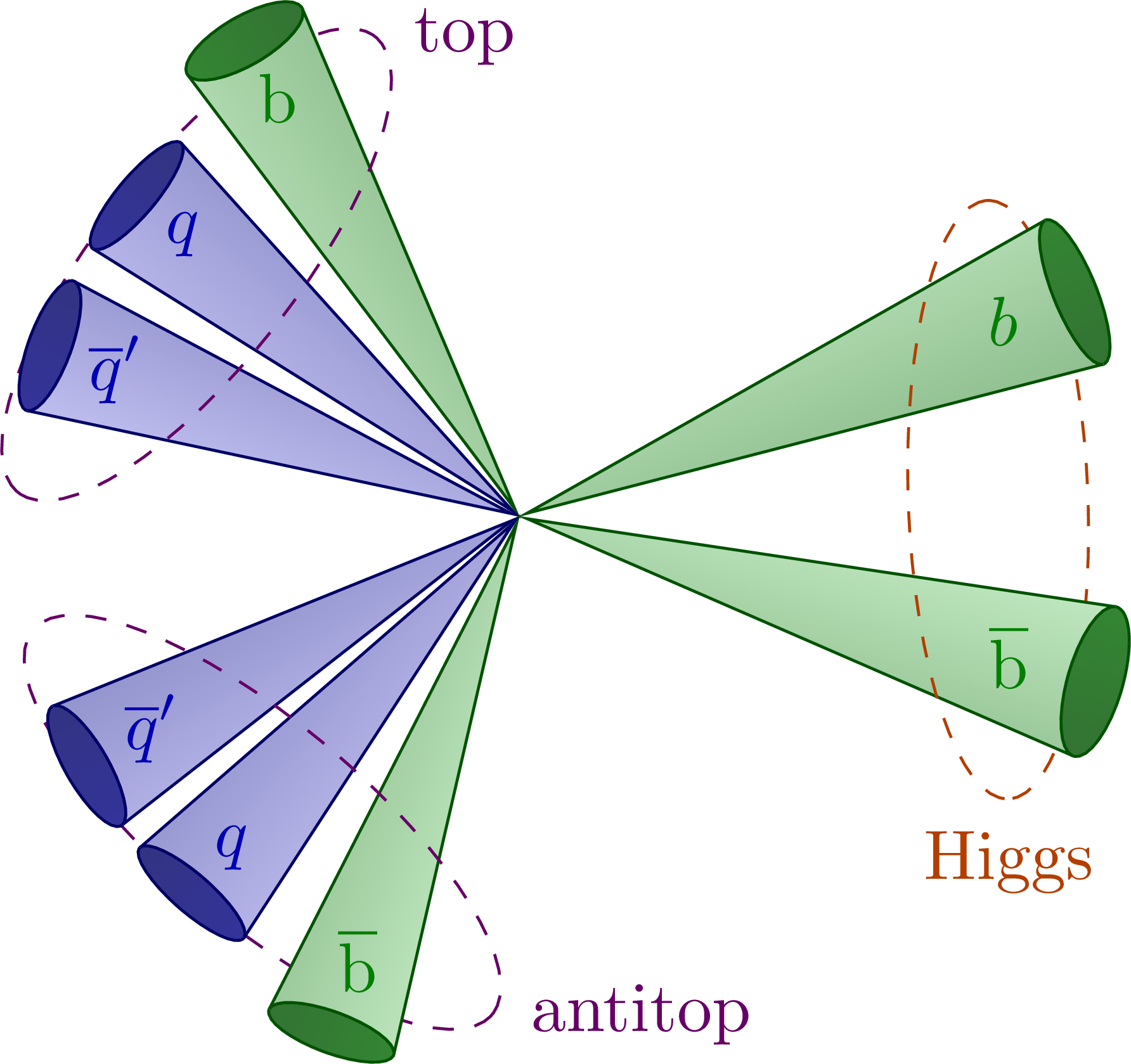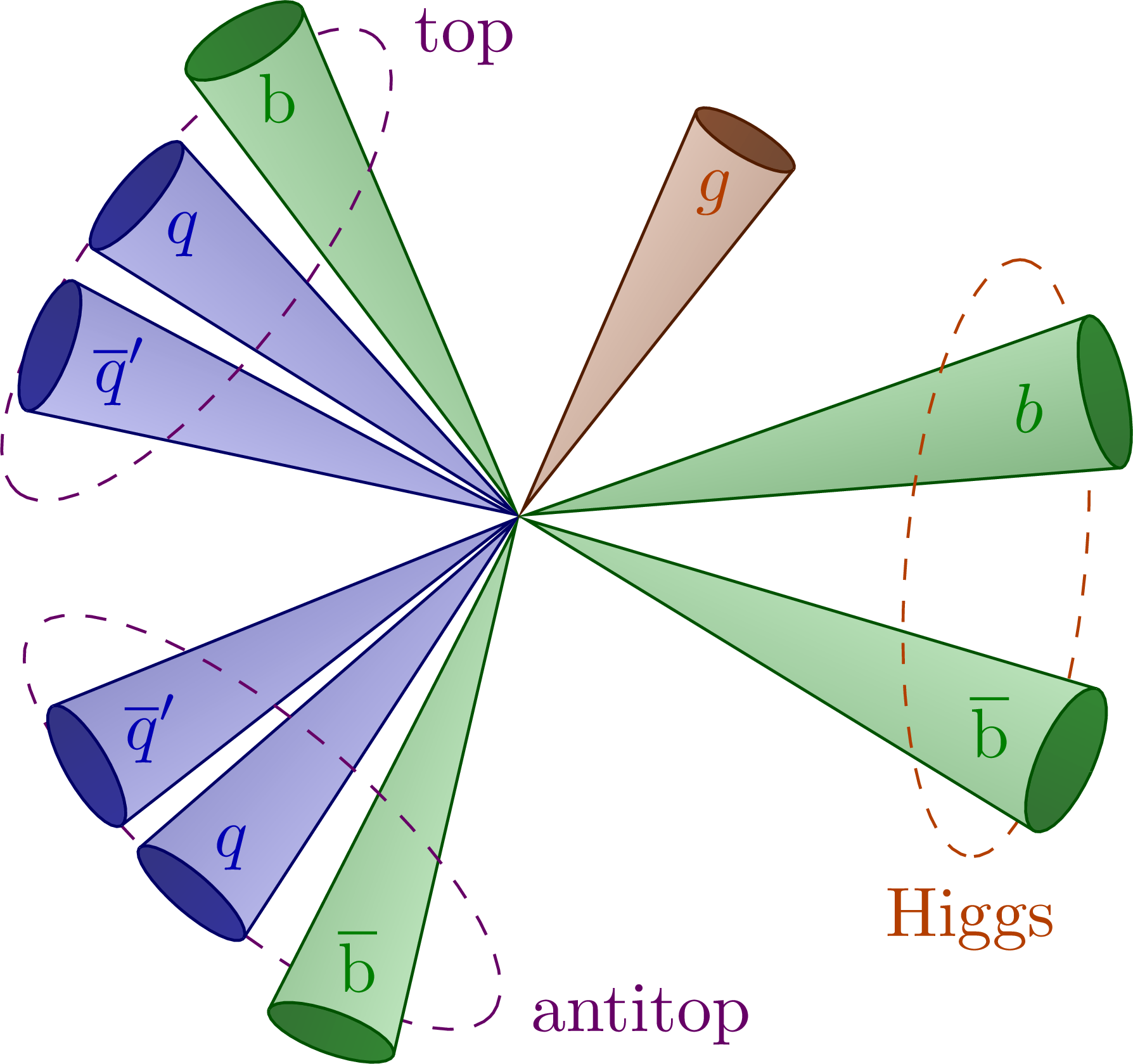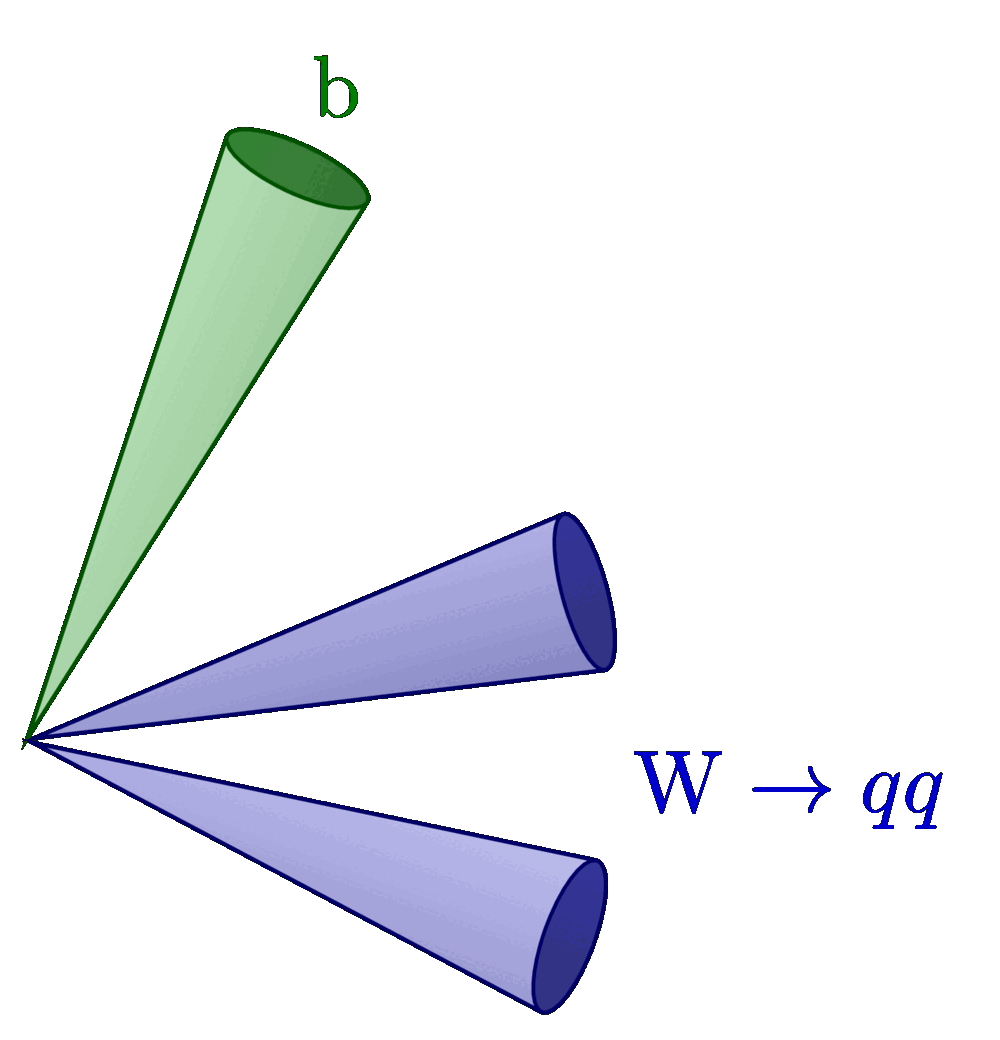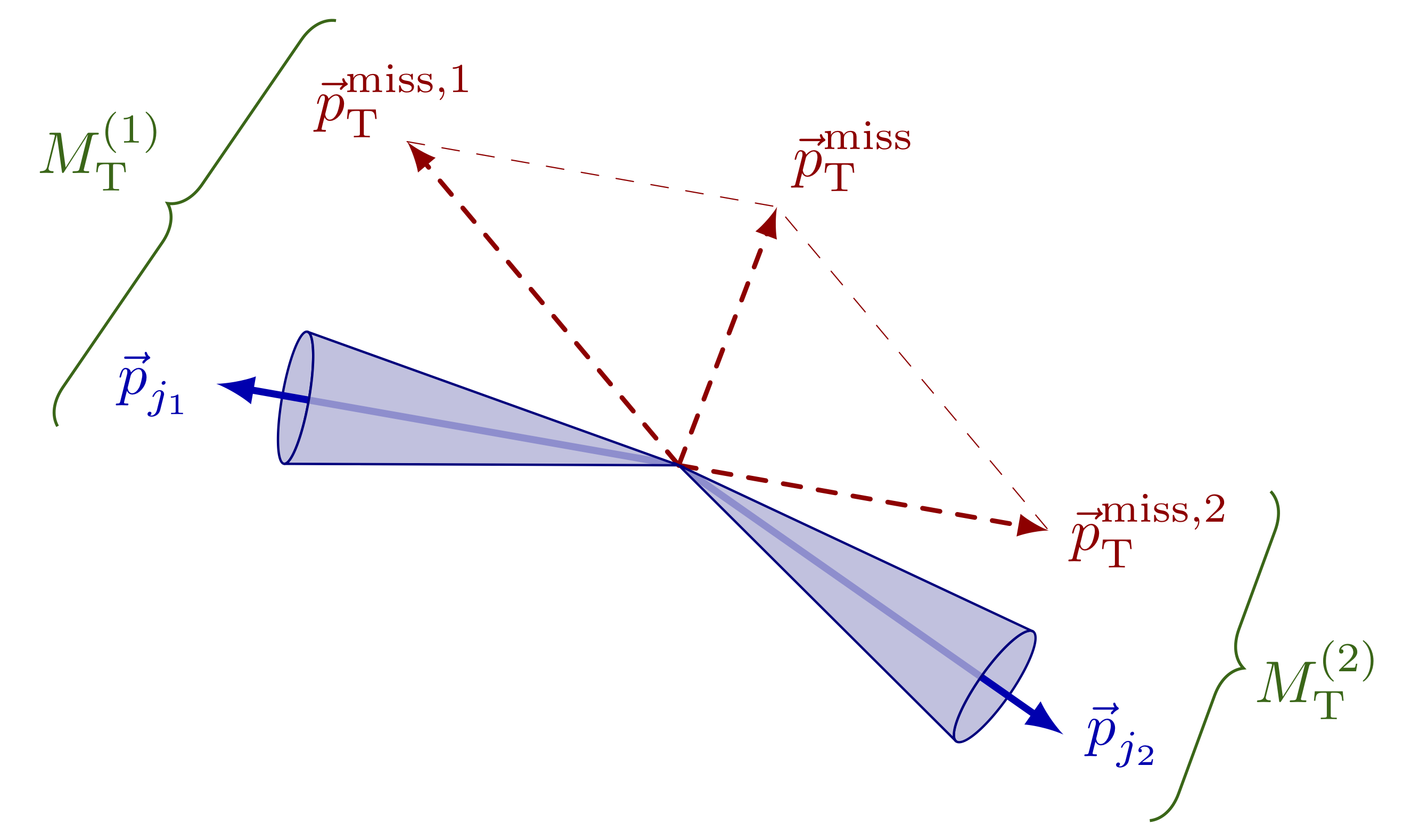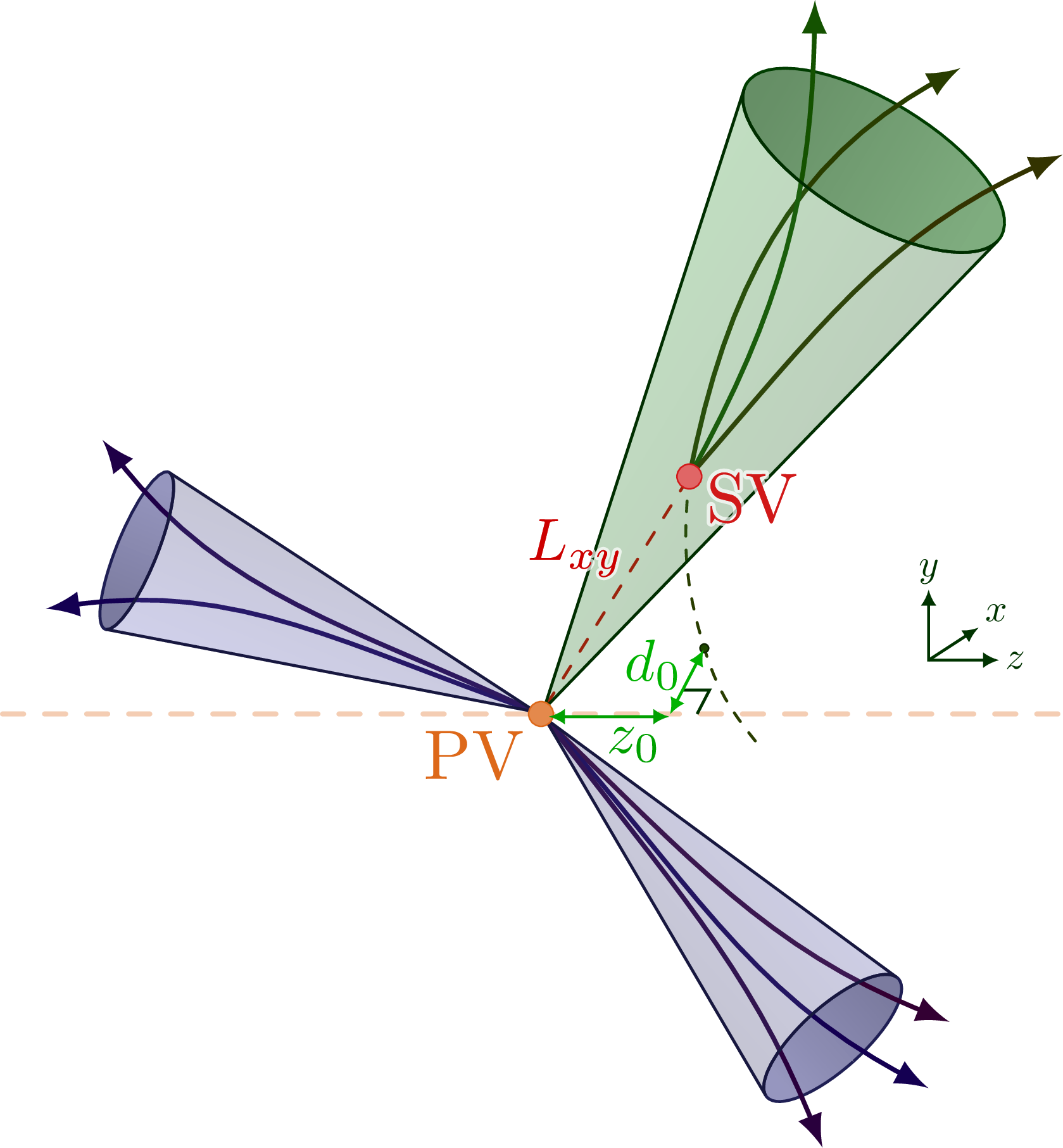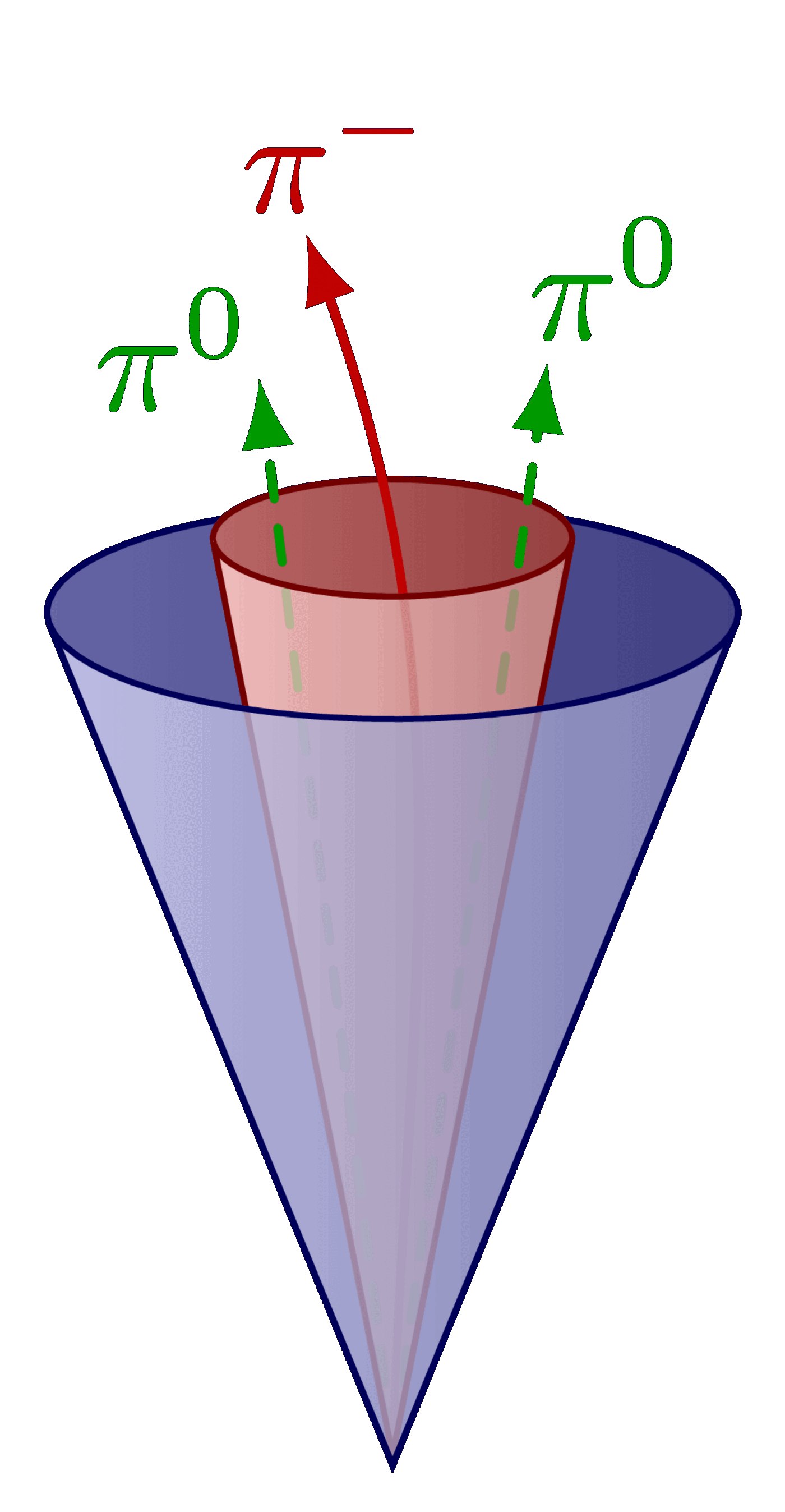Jet cones in production of top pairs (ttbar), as well as associated production with Higgs (ttH), with or without initial (ISR) or final state radiation (FSR).
For more related figures, please see the “jet” tag or the Particle Physics category. The cones are constructed with the tangent methods presented here.
ttbar with semi-leptonic decay:
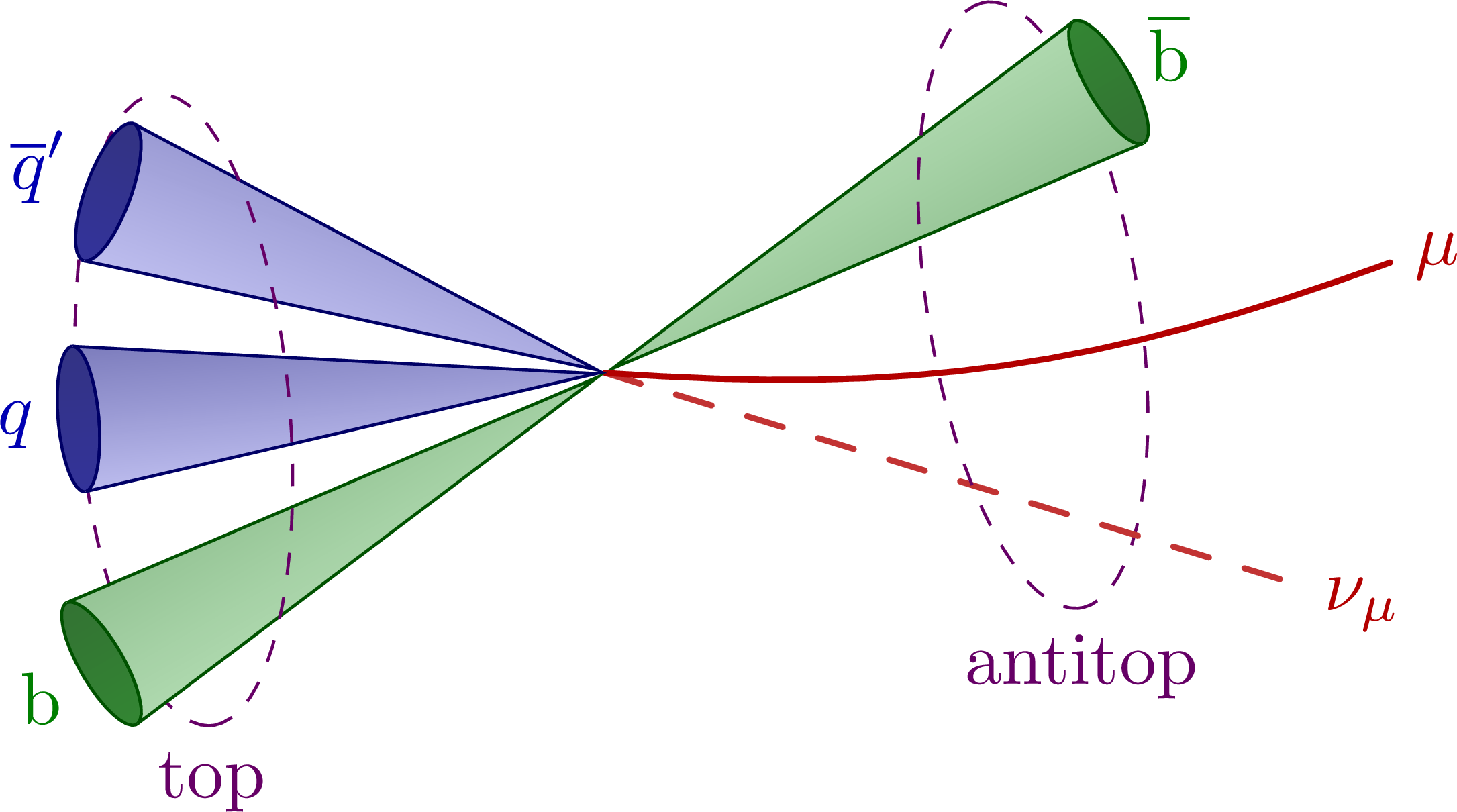
ttbar with quark/gluon radiation:
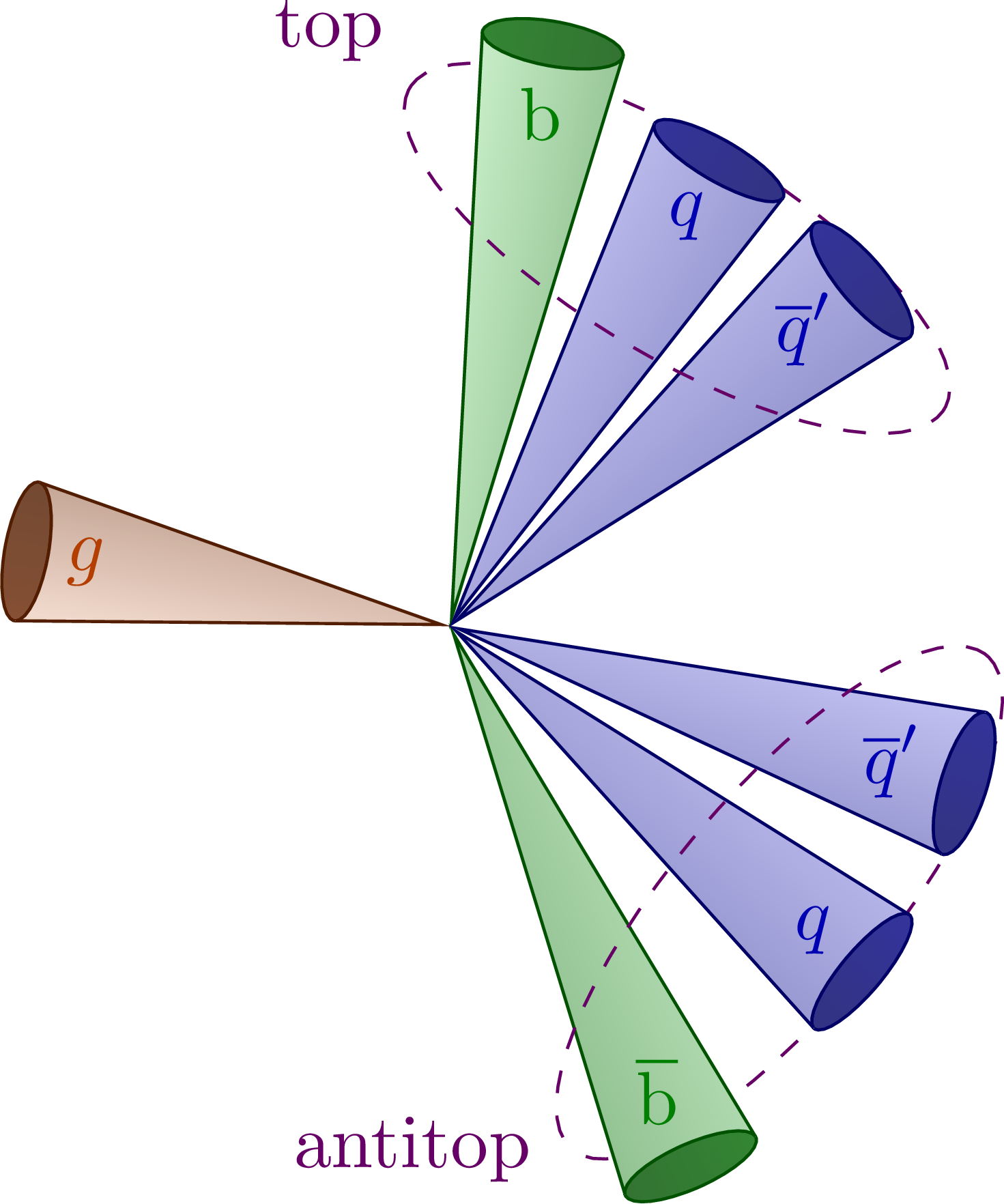
Higgs production in association with top quarks (ttH, H →bbar):
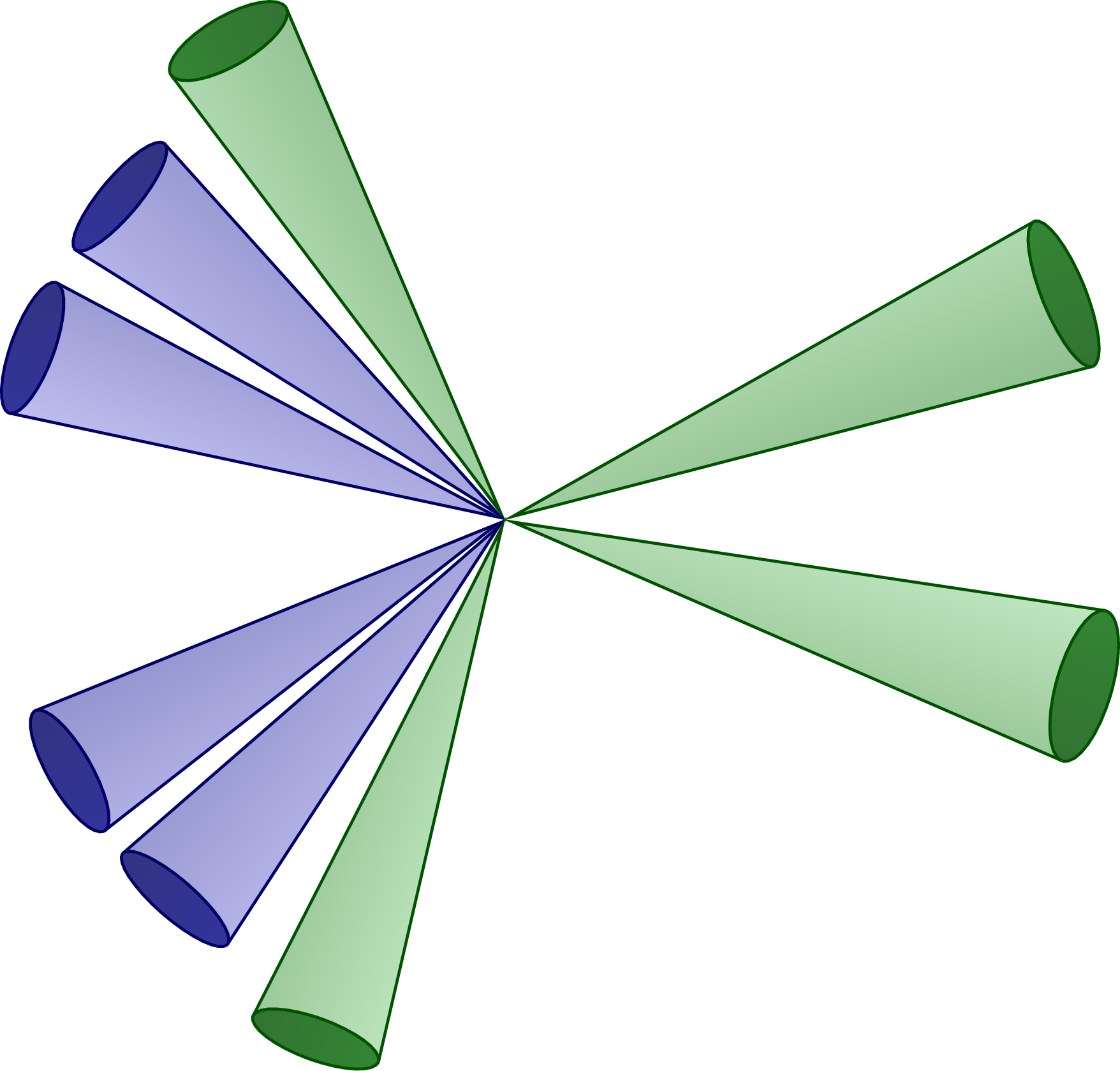
Edit and compile if you like:
% Author: Izaak Neutelings (July 2021)
% Description: ttbar & ttH jets
% Inspiration: PhD thesis by Korbinian Schweiger
\documentclass[border=3pt,tikz]{standalone}
\usepackage{amsmath}
\usepackage{physics}
\usepackage{xcolor}
\usetikzlibrary{calc}
\usetikzlibrary{math} % for \tikzmath
\tikzset{>=latex} % for LaTeX arrow head
\usetikzlibrary{decorations.pathreplacing} % for curly braces
\colorlet{myred}{red!70!black}
\colorlet{mydarkred}{red!45!black}
\colorlet{myblue}{blue!70!black}
\colorlet{mydarkblue}{blue!40!black}
\colorlet{mygreen}{green!80!black}
\colorlet{mydarkgreen}{green!50!black}
\colorlet{mypurple}{blue!50!red!80!black}
\colorlet{myorange}{orange!70!red!80!black}
\colorlet{mydarkorange}{orange!70!red!70!black}
\tikzstyle{vector}=[->,very thick,myblue,line cap=round]
\tikzstyle{ptmiss}=[->,dashed,thick,myred,line cap=round]
\tikzstyle{cone}=[thin,blue!50!black,fill=blue!50!black!30] %,fill opacity=0.8
\tikzstyle{conebase}=[cone,fill=blue!50!black!50] %,fill opacity=0.8
\tikzstyle{loose dashed}=[dash pattern=on 5pt off 5pt]
\newcommand{\qbar}{{\ensuremath{\overline{q}}}} %\xspace
\newcommand{\bbar}{{\ensuremath{\overline{\mathrm{b}}}}} %\xspace
\newcommand\jetcone[5][blue]{{
\pgfmathanglebetweenpoints{\pgfpointanchor{#2}{center}}{\pgfpointanchor{#3}{center}}
\edef\ang{#4/2}
\edef\e{#5}
\edef\vang{\pgfmathresult} % angle of vector OV
\coordinate (tmpO) at ($(#2)+(\vang:0.017)$);
\tikzmath{
coordinate \C;
\C = (tmpO)-(#3);
\x = veclen(\Cx,\Cy)*\e*sin(\ang)^2; % x coordinate P
\y = tan(\ang)*(veclen(\Cx,\Cy)-\x); % y coordinate P
\a = veclen(\Cx,\Cy)*sqrt(\e)*sin(\ang); % vertical radius
\b = veclen(\Cx,\Cy)*tan(\ang)*sqrt(1-\e*sin(\ang)^2); % horizontal radius
\angb = acos(sqrt(\e)*sin(\ang)); % angle of P in ellipse
}
\coordinate (tmpL) at ($(#3)-(\vang:\x pt)+(\vang+90:\y pt)$); % tangency
\draw[thin,#1!40!black,rotate=\vang, %,fill=#1!50!black!80
top color=#1!50!black!80,bottom color=#1!40!black!80,shading angle=\vang]
(#3) ellipse({\a pt} and {\b pt});
\draw[thin,#1!40!black,rotate=\vang,%fill=#1!80!black!40,
top color=#1!90!black!20,bottom color=#1!50!black!50,shading angle=\vang]
(tmpL) arc(180-\angb:180+\angb:{\a pt} and {\b pt})
-- (tmpO) -- cycle;
}}
\begin{document}
% TTBAR JETS - no text
\begin{tikzpicture}[scale=2.5]
\def\R{1} % scale jet length
\coordinate (O) at (0,0);
\coordinate (B1) at ( 30:1.1*\R); % b jet 1 (top)
\coordinate (J1) at ( 10:1.0*\R); % q jet 1 (top)
\coordinate (J2) at ( -12:1.0*\R); % q jet 2 (top)
\coordinate (B2) at (-150:1.1*\R); % b jet 2 (antitop)
\coordinate (J3) at ( 185:1.0*\R); % q jet 3 (antitop)
\coordinate (J4) at ( 160:1.0*\R); % q jet 4 (antitop)
% TOP 1
\jetcone[mygreen]{O}{B1}{14}{0.10}
\jetcone{O}{J1}{16}{0.08}
\jetcone{O}{J2}{16}{0.10}
% TOP 2
\jetcone[mygreen]{O}{B2}{14}{0.10}
\jetcone{O}{J3}{16}{0.08}
\jetcone{O}{J4}{16}{0.10}
\end{tikzpicture}
% TTBAR JETS
\begin{tikzpicture}[scale=2.5]
\def\R{1} % scale jet length
\coordinate (O) at (0,0);
\coordinate (B1) at ( 30:1.1*\R); % b jet 1 (top)
\coordinate (J1) at ( 10:1.0*\R); % q jet 1 (top)
\coordinate (J2) at ( -12:1.0*\R); % q jet 2 (top)
\coordinate (B2) at (-150:1.1*\R); % b jet 2 (antitop)
\coordinate (J3) at ( 185:1.0*\R); % q jet 3 (antitop)
\coordinate (J4) at ( 160:1.0*\R); % q jet 4 (antitop)
% TOP 1
\def\tang{9}
\draw[dashed,mypurple,rotate=\tang]
($(O)+(0.82*\R,0.58*\R)$) arc(90:-90:{0.2*\R} and {0.58*\R});
\jetcone[mygreen]{O}{B1}{14}{0.10}
\jetcone{O}{J1}{16}{0.08}
\jetcone{O}{J2}{16}{0.10}
\draw[dashed,mypurple,rotate=\tang]
($(O)+(0.82*\R,0.58*\R)$) arc(90:270:{0.2*\R} and {0.58*\R})
node[below] {antitop};
\node[mydarkgreen] at ($(O)!1.12!(B1)$) {\bbar};
\node[myblue] at ($(O)!1.12!(J1)$) {$q$};
\node[myblue] at ($(O)!1.14!(J2)$) {$\qbar'$};
% TOP 2
\def\tang{185}
\draw[dashed,mypurple,rotate=\tang]
($(O)+(0.8*\R,0.6*\R)$) arc(90:-90:{0.2*\R} and {0.6*\R});
\jetcone[mygreen]{O}{B2}{14}{0.10}
\jetcone{O}{J3}{16}{0.08}
\jetcone{O}{J4}{16}{0.10}
\draw[dashed,mypurple,rotate=\tang]
($(O)+(0.8*\R,0.6*\R)$) arc(90:270:{0.2*\R} and {0.6*\R})
node[pos=0,below] {top};
\node[mydarkgreen] at ($(O)!1.12!(B2)$) {b};
\node[myblue] at ($(O)!1.12!(J3)$) {$q$};
\node[myblue] at ($(O)!1.14!(J4)$) {$\qbar'$};
\end{tikzpicture}
% TTBAR JETS
\begin{tikzpicture}[scale=2.5]
\def\R{1} % scale jet length
\coordinate (O) at (0,0);
\coordinate (B1) at ( 30:1.1*\R); % b jet 1 (top)
\coordinate (J1) at ( 10:1.0*\R); % q jet 1 (top)
\coordinate (J2) at ( -12:1.0*\R); % q jet 2 (top)
\coordinate (B2) at (-150:1.1*\R); % b jet 2 (antitop)
\coordinate (J3) at ( 185:1.0*\R); % q jet 3 (antitop)
\coordinate (J4) at ( 160:1.0*\R); % q jet 4 (antitop)
% TOP 1
\def\tang{9}
\draw[dashed,mypurple,rotate=\tang]
($(O)+(0.82*\R,0.58*\R)$) arc(90:-90:{0.2*\R} and {0.58*\R});
\jetcone[mygreen]{O}{B1}{14}{0.10}
\jetcone{O}{J1}{16}{0.08}
\jetcone{O}{J2}{16}{0.10}
\draw[dashed,mypurple,rotate=\tang]
($(O)+(0.82*\R,0.58*\R)$) arc(90:270:{0.2*\R} and {0.58*\R})
node[below] {antitop};
\node[mydarkgreen] at ($(O)!0.88!(B1)$) {\bbar};
\node[myblue] at ($(O)!0.88!(J1)$) {$q$};
\node[myblue] at ($(O)!0.86!(J2)$) {$\qbar'$};
% TOP 2
\def\tang{185}
\draw[dashed,mypurple,rotate=\tang]
($(O)+(0.8*\R,0.6*\R)$) arc(90:-90:{0.2*\R} and {0.6*\R});
\jetcone[mygreen]{O}{B2}{14}{0.10}
\jetcone{O}{J3}{16}{0.08}
\jetcone{O}{J4}{16}{0.10}
\draw[dashed,mypurple,rotate=\tang]
($(O)+(0.8*\R,0.6*\R)$) arc(90:270:{0.2*\R} and {0.6*\R})
node[pos=0,below] {top};
\node[mydarkgreen] at ($(O)!0.86!(B2)$) {b};
\node[myblue] at ($(O)!0.88!(J3)$) {$q$};
\node[myblue] at ($(O)!0.86!(J4)$) {$\qbar'$};
\end{tikzpicture}
% TTBAR JETS - semileptonic
\begin{tikzpicture}[scale=2.5]
\def\R{1} % scale jet length
\coordinate (O) at (0,0);
\coordinate (B1) at ( 30:1.1*\R); % b jet 1 (top)
\coordinate (M1) at ( 8:1.5*\R); % muon (top)
\coordinate (N1) at ( -17:1.4*\R); % neutrino (top)
\coordinate (B2) at (-150:1.1*\R); % b jet 2 (antitop)
\coordinate (J3) at ( 185:1.0*\R); % q jet 3 (antitop)
\coordinate (J4) at ( 160:1.0*\R); % q jet 4 (antitop)
% TOP 1
\def\tang{9}
\draw[dashed,mypurple,rotate=\tang]
($(O)+(0.82*\R,0.58*\R)$) arc(90:-90:{0.2*\R} and {0.58*\R});
\jetcone[mygreen]{O}{B1}{14}{0.10}
%\jetcone[myred!50!white]{O}{M1}{6}{0.08}
\draw[loose dashed,thick,myred!80,line cap=round] (O) -- (N1);
\draw[myred,thick,line cap=round] (O) to[out=-4,in=-160] (M1);
\draw[dashed,mypurple,rotate=\tang]
($(O)+(0.82*\R,0.58*\R)$) arc(90:270:{0.2*\R} and {0.58*\R})
node[below] {antitop};
\node[mydarkgreen] at ($(O)!1.12!(B1)$) {\bbar};
\node[myred] at ($(O)!1.06!(M1)$) {$\mu$};
\node[myred] at ($(O)!1.07!(N1)$) {$\nu_\mu$};
% TOP 2
\def\tang{185}
\draw[dashed,mypurple,rotate=\tang]
($(O)+(0.8*\R,0.6*\R)$) arc(90:-90:{0.2*\R} and {0.6*\R});
\jetcone[mygreen]{O}{B2}{14}{0.10}
\jetcone{O}{J3}{16}{0.08}
\jetcone{O}{J4}{16}{0.10}
\draw[dashed,mypurple,rotate=\tang]
($(O)+(0.8*\R,0.6*\R)$) arc(90:270:{0.2*\R} and {0.6*\R})
node[pos=0,below] {top};
\node[mydarkgreen] at ($(O)!1.12!(B2)$) {b};
\node[myblue] at ($(O)!1.12!(J3)$) {$q$};
\node[myblue] at ($(O)!1.14!(J4)$) {$\qbar'$};
\end{tikzpicture}
% TTBAR JETS - recoiling 1
\begin{tikzpicture}[scale=2.5]
\def\R{1} % scale jet length
\coordinate (O) at (0,0);
\coordinate (B1) at ( 80:1.1*\R); % b jet 1 (top)
\coordinate (J1) at ( 60:1.0*\R); % q jet 1 (top)
\coordinate (J2) at ( 40:1.0*\R); % q jet 2 (top)
\coordinate (B2) at (-66:1.1*\R); % b jet 2 (antitop)
\coordinate (J3) at (-40:1.0*\R); % q jet 3 (antitop)
\coordinate (J4) at (-17:1.0*\R); % q jet 4 (antitop)
\coordinate (G1) at (170:0.8*\R); % gluon (ISR/FSR)
% TOP 1
\def\tang{59}
\draw[dashed,mypurple,rotate=\tang]
($(O)+(0.82*\R,0.58*\R)$) arc(90:-90:{0.2*\R} and {0.58*\R});
\jetcone[mygreen]{O}{B1}{14}{0.10}
\jetcone{O}{J1}{16}{0.08}
\jetcone{O}{J2}{16}{0.10}
\draw[dashed,mypurple,rotate=\tang]
($(O)+(0.82*\R,0.58*\R)$) arc(90:270:{0.2*\R} and {0.58*\R})
node[pos=0,above left=0] {top};
\node[mydarkgreen] at ($(O)!0.88!(B1)$) {b};
\node[myblue] at ($(O)!0.88!(J1)$) {$q$};
\node[myblue] at ($(O)!0.86!(J2)$) {$\qbar'$};
% TOP 2
\def\tang{-40}
\draw[dashed,mypurple,rotate=\tang]
($(O)+(0.8*\R,0.6*\R)$) arc(90:-90:{0.2*\R} and {0.6*\R});
\jetcone[mygreen]{O}{B2}{14}{0.10}
\jetcone{O}{J3}{16}{0.08}
\jetcone{O}{J4}{16}{0.10}
\draw[dashed,mypurple,rotate=\tang]
($(O)+(0.8*\R,0.6*\R)$) arc(90:270:{0.2*\R} and {0.6*\R})
node[left=2] {antitop};
\node[mydarkgreen] at ($(O)!0.86!(B2)$) {\bbar};
\node[myblue] at ($(O)!0.88!(J3)$) {$q$};
\node[myblue] at ($(O)!0.86!(J4)$) {$\qbar'$};
% GLUON
\jetcone[myorange]{O}{G1}{19}{0.10}
\node[mydarkorange] at ($(O)!0.86!(G1)$) {$g$};
\end{tikzpicture}
% TTBAR JETS - recoiling 2
\begin{tikzpicture}[scale=2.5]
\def\R{1} % scale jet length
\coordinate (O) at (0,0);
\coordinate (B1) at ( 80:1.1*\R); % b jet 1 (top)
\coordinate (J1) at ( 60:1.0*\R); % q jet 1 (top)
\coordinate (J2) at ( 40:1.0*\R); % q jet 2 (top)
\coordinate (B2) at (-66:1.1*\R); % b jet 2 (antitop)
\coordinate (J3) at (-40:1.0*\R); % q jet 3 (antitop)
\coordinate (J4) at (-17:1.0*\R); % q jet 4 (antitop)
\coordinate (G1) at (158:0.80*\R); % gluon 1 (ISR/FSR)
\coordinate (G2) at (196:0.82*\R); % gluon 2 (ISR/FSR)
% TOP 1
\def\tang{59}
\draw[dashed,mypurple,rotate=\tang]
($(O)+(0.82*\R,0.58*\R)$) arc(90:-90:{0.2*\R} and {0.58*\R});
\jetcone[mygreen]{O}{B1}{14}{0.10}
\jetcone{O}{J1}{16}{0.08}
\jetcone{O}{J2}{16}{0.10}
\draw[dashed,mypurple,rotate=\tang]
($(O)+(0.82*\R,0.58*\R)$) arc(90:270:{0.2*\R} and {0.58*\R})
node[pos=0,above left=0] {top};
\node[mydarkgreen] at ($(O)!0.88!(B1)$) {b};
\node[myblue] at ($(O)!0.88!(J1)$) {$q$};
\node[myblue] at ($(O)!0.86!(J2)$) {$\qbar'$};
% TOP 2
\def\tang{-40}
\draw[dashed,mypurple,rotate=\tang]
($(O)+(0.8*\R,0.6*\R)$) arc(90:-90:{0.2*\R} and {0.6*\R});
\jetcone[mygreen]{O}{B2}{14}{0.10}
\jetcone{O}{J3}{16}{0.08}
\jetcone{O}{J4}{16}{0.10}
\draw[dashed,mypurple,rotate=\tang]
($(O)+(0.8*\R,0.6*\R)$) arc(90:270:{0.2*\R} and {0.6*\R})
node[left=2] {antitop};
\node[mydarkgreen] at ($(O)!0.86!(B2)$) {\bbar};
\node[myblue] at ($(O)!0.88!(J3)$) {$q$};
\node[myblue] at ($(O)!0.86!(J4)$) {$\qbar'$};
% GLUON
\jetcone[myorange]{O}{G1}{21}{0.10}
\jetcone[myorange]{O}{G2}{19}{0.10}
\node[mydarkorange] at ($(O)!0.86!(G1)$) {$g$};
\node[mydarkorange] at ($(O)!0.86!(G2)$) {$g$};
\end{tikzpicture}
% TTBAR JETS - recoiling 3 (no text)
\begin{tikzpicture}[scale=2.5]
\def\R{1} % scale jet length
\coordinate (O) at (0,0);
\coordinate (B1) at ( 100:1.1*\R); % b jet 1
\coordinate (J1) at ( 130:1.0*\R); % q jet 1
\coordinate (J2) at ( 150:1.0*\R); % q jet 2
\coordinate (B2) at (-100:1.1*\R); % b jet 2
\coordinate (J3) at (-120:1.0*\R); % q jet 3
\coordinate (J4) at (-145:1.0*\R); % q jet 4
\coordinate (R1) at ( 20:0.75*\R); % recoil jet 1
\coordinate (R2) at ( -20:0.75*\R); % recoil jet 2
% TOP 1
\jetcone[mygreen]{O}{B1}{14}{0.10}
\jetcone{O}{J1}{16}{0.08}
\jetcone{O}{J2}{16}{0.10}
% TOP 2
\jetcone[mygreen]{O}{B2}{14}{0.10}
\jetcone{O}{J3}{16}{0.08}
\jetcone{O}{J4}{16}{0.10}
% RECOIL
\jetcone[myorange]{O}{R1}{17}{0.08}
\jetcone[myorange]{O}{R2}{17}{0.12}
\end{tikzpicture}
% ttH JETS - no text
\begin{tikzpicture}[scale=2.5]
\def\R{1} % scale jet length
\coordinate (O) at (0,0);
\coordinate (B1) at ( 120:1.1*\R); % b jet 1 (top)
\coordinate (J1) at ( 140:1.0*\R); % q jet 1 (top)
\coordinate (J2) at ( 160:1.0*\R); % q jet 2 (top)
\coordinate (B2) at (-110:1.1*\R); % b jet 2 (antitop)
\coordinate (J3) at (-131:1.0*\R); % q jet 3 (antitop)
\coordinate (J4) at (-150:1.0*\R); % q jet 4 (antitop)
\coordinate (H1) at ( 22:1.2*\R); % b jet 3 (Higgs)
\coordinate (H2) at ( -16:1.2*\R); % b jet 4 (Higgs)
% TOP 1
\jetcone[mygreen]{O}{B1}{14}{0.14}
\jetcone{O}{J1}{16}{0.08}
\jetcone{O}{J2}{16}{0.10}
% TOP 2
\jetcone[mygreen]{O}{B2}{14}{0.10}
\jetcone{O}{J3}{16}{0.08}
\jetcone{O}{J4}{16}{0.10}
% HIGGS
\jetcone[mygreen]{O}{H1}{15}{0.08}
\jetcone[mygreen]{O}{H2}{15}{0.13}
\end{tikzpicture}
% ttH JETS
\begin{tikzpicture}[scale=2.5]
\def\R{1} % scale jet length
\coordinate (O) at (0,0);
\coordinate (B1) at ( 120:1.1*\R); % b jet 1 (top)
\coordinate (J1) at ( 140:1.0*\R); % q jet 1 (top)
\coordinate (J2) at ( 160:1.0*\R); % q jet 2 (top)
\coordinate (B2) at (-110:1.1*\R); % b jet 2 (antitop)
\coordinate (J3) at (-131:1.0*\R); % q jet 3 (antitop)
\coordinate (J4) at (-150:1.0*\R); % q jet 4 (antitop)
\coordinate (H1) at ( 22:1.2*\R); % b jet 3 (Higgs)
\coordinate (H2) at ( -16:1.2*\R); % b jet 4 (Higgs)
% TOP 1
\def\tang{142}
\draw[dashed,mypurple,rotate=\tang]
($(O)+(0.82*\R,0.58*\R)$) arc(90:-90:{0.2*\R} and {0.58*\R});
\jetcone[mygreen]{O}{B1}{14}{0.14}
\jetcone{O}{J1}{16}{0.08}
\jetcone{O}{J2}{16}{0.10}
\draw[dashed,mypurple,rotate=\tang]
($(O)+(0.82*\R,0.58*\R)$) arc(90:270:{0.2*\R} and {0.58*\R})
node[right=2] {top};
\node[mydarkgreen] at ($(O)!0.88!(B1)$) {b};
\node[myblue] at ($(O)!0.88!(J1)$) {$q$};
\node[myblue] at ($(O)!0.86!(J2)$) {$\qbar'$};
% TOP 2
\def\tang{-130}
\draw[dashed,mypurple,rotate=\tang]
($(O)+(0.8*\R,0.6*\R)$) arc(90:-90:{0.2*\R} and {0.6*\R});
\jetcone[mygreen]{O}{B2}{14}{0.10}
\jetcone{O}{J3}{16}{0.08}
\jetcone{O}{J4}{16}{0.10}
\draw[dashed,mypurple,rotate=\tang]
($(O)+(0.8*\R,0.6*\R)$) arc(90:270:{0.2*\R} and {0.6*\R})
node[pos=0,right=2] {antitop};
\node[mydarkgreen] at ($(O)!0.86!(B2)$) {\bbar};
\node[myblue] at ($(O)!0.88!(J3)$) {$q$};
\node[myblue] at ($(O)!0.85!(J4)$) {$\qbar'$};
% HIGGS
\def\tang{2}
\draw[dashed,mydarkorange,rotate=\tang]
($(O)+(0.96*\R,0.6*\R)$) arc(90:-90:{0.18*\R} and {0.6*\R});
\jetcone[mygreen]{O}{H1}{15}{0.08}
\jetcone[mygreen]{O}{H2}{15}{0.13}
\draw[dashed,mydarkorange,rotate=\tang]
($(O)+(0.96*\R,0.6*\R)$) arc(90:270:{0.18*\R} and {0.6*\R})
node[below=1] {Higgs};
\node[mydarkgreen] at ($(O)!0.87!(H1)$) {$b$};
\node[mydarkgreen] at ($(O)!0.85!(H2)$) {$\bbar$};
\end{tikzpicture}
% ttH JETS - recoil
\begin{tikzpicture}[scale=2.5]
\def\R{1} % scale jet length
\coordinate (O) at (0,0);
\coordinate (B1) at ( 120:1.1*\R); % b jet 1 (top)
\coordinate (J1) at ( 140:1.0*\R); % q jet 1 (top)
\coordinate (J2) at ( 160:1.0*\R); % q jet 2 (top)
\coordinate (B2) at (-110:1.1*\R); % b jet 2 (antitop)
\coordinate (J3) at (-131:1.0*\R); % q jet 3 (antitop)
\coordinate (J4) at (-150:1.0*\R); % q jet 4 (antitop)
\coordinate (H1) at ( 12:1.2*\R); % b jet 3 (Higgs)
\coordinate (H2) at ( -24:1.2*\R); % b jet 4 (Higgs)
\coordinate (G1) at ( 59:0.88*\R); % gluon
% TOP 1
\def\tang{142}
\draw[dashed,mypurple,rotate=\tang]
($(O)+(0.82*\R,0.58*\R)$) arc(90:-90:{0.2*\R} and {0.58*\R});
\jetcone[mygreen]{O}{B1}{14}{0.14}
\jetcone{O}{J1}{16}{0.08}
\jetcone{O}{J2}{16}{0.10}
\draw[dashed,mypurple,rotate=\tang]
($(O)+(0.82*\R,0.58*\R)$) arc(90:270:{0.2*\R} and {0.58*\R})
node[right=2] {top};
\node[mydarkgreen] at ($(O)!0.88!(B1)$) {b};
\node[myblue] at ($(O)!0.88!(J1)$) {$q$};
\node[myblue] at ($(O)!0.85!(J2)$) {$\qbar'$};
% TOP 2
\def\tang{-130}
\draw[dashed,mypurple,rotate=\tang]
($(O)+(0.8*\R,0.6*\R)$) arc(90:-90:{0.2*\R} and {0.6*\R});
\jetcone[mygreen]{O}{B2}{14}{0.10}
\jetcone{O}{J3}{16}{0.08}
\jetcone{O}{J4}{16}{0.10}
\draw[dashed,mypurple,rotate=\tang]
($(O)+(0.8*\R,0.6*\R)$) arc(90:270:{0.2*\R} and {0.6*\R})
node[pos=0,right=2] {antitop};
\node[mydarkgreen] at ($(O)!0.86!(B2)$) {\bbar};
\node[myblue] at ($(O)!0.88!(J3)$) {$q$};
\node[myblue] at ($(O)!0.85!(J4)$) {$\qbar'$};
% HIGGS
\def\tang{-5}
\draw[dashed,mydarkorange,rotate=\tang]
($(O)+(0.96*\R,0.6*\R)$) arc(90:-90:{0.18*\R} and {0.6*\R});
\jetcone[mygreen]{O}{H1}{15}{0.08}
\jetcone[mygreen]{O}{H2}{15}{0.13}
\draw[dashed,mydarkorange,rotate=\tang]
($(O)+(0.96*\R,0.6*\R)$) arc(90:270:{0.18*\R} and {0.6*\R})
node[below=1] {Higgs};
\node[mydarkgreen] at ($(O)!0.87!(H1)$) {$b$};
\node[mydarkgreen] at ($(O)!0.86!(H2)$) {$\bbar$};
% RECOIL
\jetcone[myorange]{O}{G1}{15}{0.08}
\node[mydarkorange] at ($(O)!0.86!(G1)$) {$g$};
\end{tikzpicture}
\end{document}
Click to download: jets_ttbar.tex • jets_ttbar.pdf
Open in Overleaf: jets_ttbar.tex

